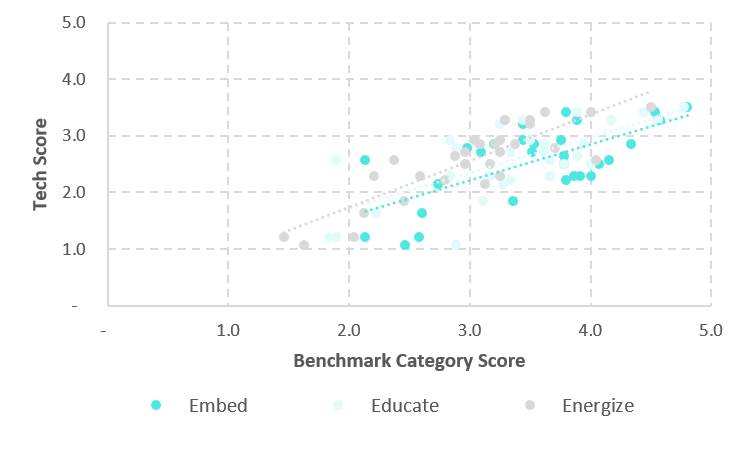Key Findings
Find out how we are applying the CSRtech.org research at EdTech startup Prospela.com
Prospela.com helps companies & charities have authentic scaleable outreach to underserved students through E-Mentoring. Talk to us!
Use of tech
Use of technology was strongly correlated to overall high performance on the benchmarks across all tiers (0.82 at a 99% CI), although tech’s usefulness differed across the individual sub-components of each benchmark, and in some cases was not relevant at all (see the individual benchmark pages for details).
Performance on benchmarks strongly correlated to use of tech

For each of the three benchmark groups, tech was generally helpful for:
Embed
Educate
Energize
Recommendations
1) The Benchmarks
The ten benchmarks are recommended as defining the sub-components of strong corporate volunteerism practice. In setting and executing their volunteerism strategy, companies (of all shapes and sizes) should use them to guide their actions, having an awareness of the typical strengths and development areas for each tier, as discussed within each individual benchmark.
2) Decentralise CSR
“Culture eats strategy for breakfast”
– Peter Drucker, management consultant
As observed in most of the high-performing companies across tiers and in the literature, CSR and corporate volunteerism were never held tightly to a centralised team at company HQ. Senior leadership were generally vocal about, and often themselves engaged in, employee volunteerism, but key to success was having a grassroots, business-wide involvement in setting volunteerism strategy.
3) Treat volunteer management as a marketing machine
CSR Leads at top performing companies often saw marketing as a key tenet of their role: not for making headlines or propaganda, but for:
4) Delegate to third-party partners: it’s critical
Established companies took the lead in being particularly comfortable with what they are and what they are not. They tended to outsource parts where third-party experts already had infrastructure in place to avoid reinventing the wheel (even where they had technical capability in-house to build a tool themselves, Airbnb being just one example).
Particularly useful in educational initiatives – where both educators & employers often used the phrase “we don’t speak the same language” – a third-party operational partner managing the day-to-day logistics can make all the difference to long-term fruitful partnerships free of logistical fuss, frustrations over communication and mismatched expectations.
The same can be said for educational institutions. Stanford and MIT, some of the top universities globally, have robust employer networks for their students to tap into, but it’s more than a full-time job. If you do not have the luxury of a staff member dedicated to networking and managing employer relationships, as many schools do not, this should be outsourced to third-party partners.
Acting as a broker, third-party partners can also help corporates take a more strategic approach to finding school, social enterprises and non-profit partners to work with, rather than (for example) simply connecting with a senior leader’s old school or overwhelming smaller partners with their sheer numbers of employee volunteers.
Limitations
Next: Read onwards to The Benchmarks >>
Copyright © 2019 by Emma Sullivan. The moral right of the author has been asserted.
The views and opinions expressed in this report and its content are those of the author and not of the
Winston Churchill Memorial Trust or its partners, which have no responsibility or liability for any part of the report.
CSRtech.org is made with ♥ by Prospela Group Ltd | Company No: 10741293